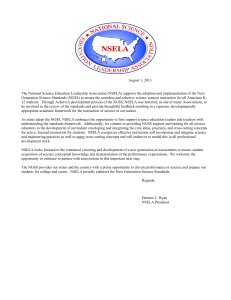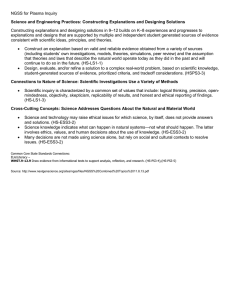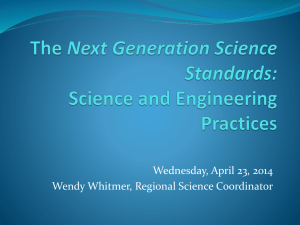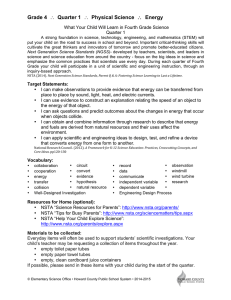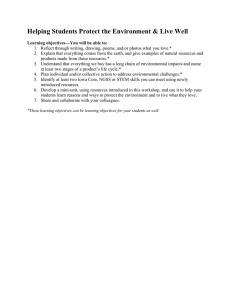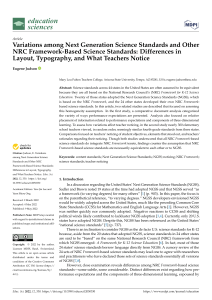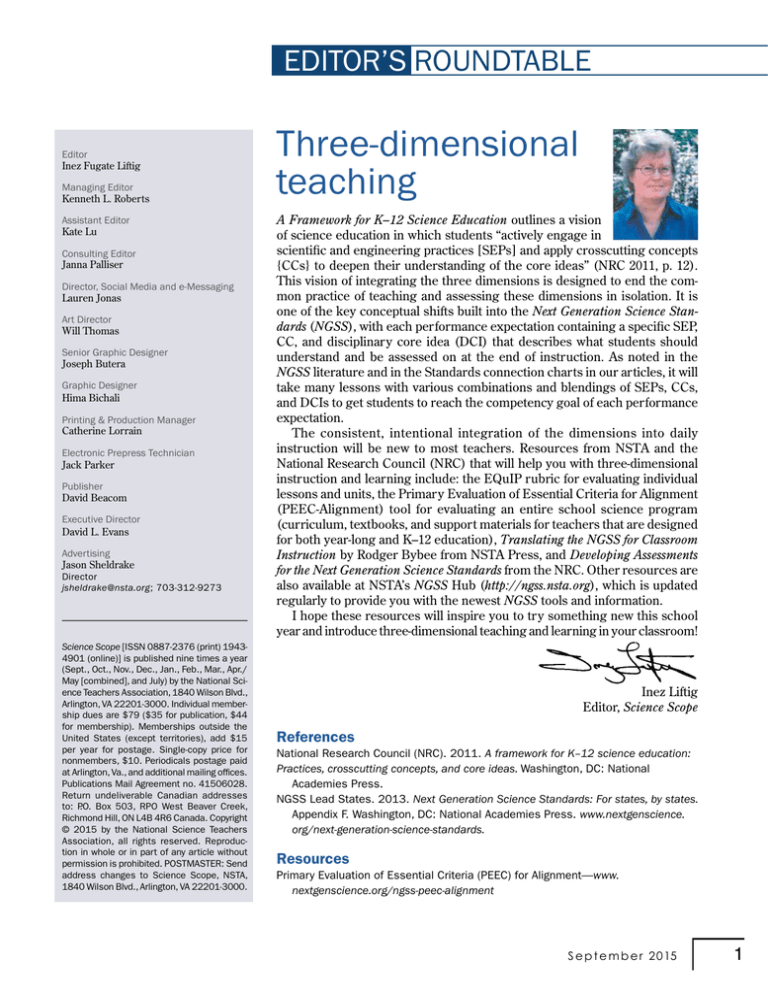
EDITOR’S ROUNDTABLE
Editor
Inez Fugate Liftig
Managing Editor
Kenneth L. Roberts
Assistant Editor
Kate Lu
Consulting Editor
Janna Palliser
Director, Social Media and e-Messaging
Lauren Jonas
Art Director
Will Thomas
Senior Graphic Designer
Joseph Butera
Graphic Designer
Hima Bichali
Printing & Production Manager
Catherine Lorrain
Electronic Prepress Technician
Jack Parker
Publisher
David Beacom
Executive Director
David L. Evans
Advertising
Jason Sheldrake
Director
jsheldrake@nsta.org; 703-312-9273
Science Scope [ISSN 0887-2376 (print) 19434901 (online)] is published nine times a year
(Sept., Oct., Nov., Dec., Jan., Feb., Mar., Apr./
May [combined], and July) by the National Science Teachers Association, 1840 Wilson Blvd.,
Arlington, VA 22201-3000. Individual membership dues are $79 ($35 for publication, $44
for membership). Memberships outside the
United States (except territories), add $15
per year for postage. Single-copy price for
nonmembers, $10. Periodicals postage paid
at Arlington, Va., and additional mailing offices.
Publications Mail Agreement no. 41506028.
Return undeliverable Canadian addresses
to: P.O. Box 503, RPO West Beaver Creek,
Richmond Hill, ON L4B 4R6 Canada. Copyright
© 2015 by the National Science Teachers
Association, all rights reserved. Reproduction in whole or in part of any article without
permission is prohibited. POSTMASTER: Send
address changes to Science Scope, NSTA,
1840 Wilson Blvd., Arlington, VA 22201-3000.
Three-dimensional
teaching
A Framework for K–12 Science Education outlines a vision
of science education in which students “actively engage in
scientific and engineering practices [SEPs] and apply crosscutting concepts
{CCs} to deepen their understanding of the core ideas” (NRC 2011, p. 12).
This vision of integrating the three dimensions is designed to end the common practice of teaching and assessing these dimensions in isolation. It is
one of the key conceptual shifts built into the Next Generation Science Standards (NGSS), with each performance expectation containing a specific SEP,
CC, and disciplinary core idea (DCI) that describes what students should
understand and be assessed on at the end of instruction. As noted in the
NGSS literature and in the Standards connection charts in our articles, it will
take many lessons with various combinations and blendings of SEPs, CCs,
and DCIs to get students to reach the competency goal of each performance
expectation.
The consistent, intentional integration of the dimensions into daily
instruction will be new to most teachers. Resources from NSTA and the
National Research Council (NRC) that will help you with three-dimensional
instruction and learning include: the EQuIP rubric for evaluating individual
lessons and units, the Primary Evaluation of Essential Criteria for Alignment
(PEEC-Alignment) tool for evaluating an entire school science program
(curriculum, textbooks, and support materials for teachers that are designed
for both year-long and K–12 education), Translating the NGSS for Classroom
Instruction by Rodger Bybee from NSTA Press, and Developing Assessments
for the Next Generation Science Standards from the NRC. Other resources are
also available at NSTA’s NGSS Hub (http://ngss.nsta.org), which is updated
regularly to provide you with the newest NGSS tools and information.
I hope these resources will inspire you to try something new this school
year and introduce three-dimensional teaching and learning in your classroom!
Inez Liftig
Editor, Science Scope
References
National Research Council (NRC). 2011. A framework for K–12 science education:
Practices, crosscutting concepts, and core ideas. Washington, DC: National
Academies Press.
NGSS Lead States. 2013. Next Generation Science Standards: For states, by states.
Appendix F. Washington, DC: National Academies Press. www.nextgenscience.
org/next-generation-science-standards.
Resources
Primary Evaluation of Essential Criteria (PEEC) for Alignment—www.
nextgenscience.org/ngss-peec-alignment
S e p t e m b e r 2 0 15
1



